|
Car-Free Day September 23, 2024
Benefits of Public Transportation
Safety
Public transportation is one of the safest modes of travel in the United States. In fact, riding a transit bus is 91 times
safer than car travel!
Saves Money
According to the American Automobile Association, the estimated cost of driving a single-occupant vehicle is between $4,826
and $9,685, depending on the size of the car and mileage. The annual average cost for public transportation for one adult
ranges from $200 to $2,000 depending on mileage, time of day, type of vehicle, or service.
Improves Air Quality
Public transportation helps promote cleaner air by reducing automobile use, which can exacerbate smog and public health problems.
For each mile traveled, fewer pollutants are emitted by transit vehicles than by a single-passenger automobile.
Reduces Energy Consumption
Public transportation can significantly reduce dependency on gasoline by reducing auto fuel consumption by 1.5 billion gallons
annually. For example, a person who commutes 30 miles each way daily could save an estimated 944 gallons of gasoline every
year by switching from using a car to using public transportation.
https://www.embarkok.com/streetcar/at-a-glance
STREETCAR WITH RAIL DIRECTORY
Opening Sequence - "The Flintstones"
Ralph thinks if buy expensive orderves and wine, he can get a raise from his boss. Instead, he gets a 17 a week cut (62 to
45).
TRANSPORTATION PAGE DIRECTORY
TRANSPORTATION FOR ALL
WALK N' ROLL
Bicycles
WHAT ABOUT TRAINS? "THE IRON HORSE"
WORLD CIRCLE LOOP LINES & BALTIMORE LEGEND
BUS & AUTO
TIRES TYRES EVERYWHERE
HIGHWAY TO KNOW-WHERE
STREETCAR VERSUS BUS
STREETCAR REVIVAL

STREETCAR ROUTES TODAY
SCHOOL STREETCARS
MARYLAND VERSUS THE NETHERLANDS
HISTORY OF TRANSIT
MARYLAND DEPARTMENT OF TRANSPORTATION: MDTA & MTA
NOISE POLLUTION
TRANSIT COMPARISON
WE WANT STREETCAR ROUTES NOW

STREETCAR TROLLEY FILMS, MUSIC, & FOLKLORE

TRAIN AND STREETCAR CAREERS
Baltimore Transportation Pictures
TRANSPORTATION REPARATIONS

MARYLAND VERSUS THE NETHERLANDS

FERRIES ~ COMEBACK AGAIN
AIRPLANES, BALLOONS, BLIMPS, & JETS
WORLD TRANSIT
DIRT BIKES, MOPEDS, MOTORCYCLES, and SUBWAYS
TRAINS VERSUS TRUCKS AND VANS
FREIGHT: TRAINS & TRUCKS
CELEBRITY PUBLIC TRANSPORTATION ADVOCATES
Reimagined Penn Station Would Relocate Drop-off Area. Should Cars or Buses get Curbside Priority?" - The Baltimore Banner
(August 5th, 2024)
"Pavement Removal Fact Sheet" - Prince Georges County (2020)
Chelsea experimentation in Boston:
"Heat radiating off asphalt, concrete, and bricks overnight can disrupt sleep. Lack of sleep can aggravate chronic conditions
such as heart disease, diabetes and anxiety. Some researchers forecast more deaths connected to excessive nighttime heat."
* Reduce/Reducing Pavement: YES.
* Paint streets: NO. Paint is not durable and produces too much glare for high-speed roadways. Paint attracts dirt and horrid
scuff marks from motor vehicles, especially busses and trucks...
* Cool streets through Shot blasting asphalt: NO. Why? Destroys roads prematurely.
* Shot blasting and paint make light and heat ricochet to hit buildings with excess heat. NO - AND NO.
* Plant Trees: YES.
* Pavement Removal: Remove excessive and unused parking lots in first place: YES.
* Pavement Removal: Remove paved/concrete/cemented backyards: YES.
"And, the light that bounces off lighter, reflective pavement may get absorbed by pedestrians. It is more like walking
on concrete than asphalt. Cambridge hasn’t had any complaints, but Beuttell gets the concern. 'It can actually be quite
a bit less comfortable on a lighter surface than a darker surface, because you're getting hit not only by the sun, but also
by that heat reflecting off the pavement.'” - Kevin Beuttell, Supervising landscape architect for Cambridge.
Hint: It's not "chilly" or "cool" in summer anymore.
Arizona: "Sharing the Streets with Streetcars: How to Ride Alongside Streetcars and Cross Tracks Safely" - RTA
Kansas City: "North Rail Streetcar Study" - (July 14, 2014)
Page 6: "Baltimore’s Hierarchy of Modes"
"Legionella Found During Water Test at Social Security Administration" - Federal Times (July 10, 2024)
Additional $$$$ 2025: "$95.1 million for Purple Line Light rail construction" - Maryland Budget Highlights Fiscal Year 2025
[Page 23]
"America is on the cusp of a new golden age, but we will have the courage to seize it. We're going to take it. We're going
to make it a current. I mean, and we're going to bring this into a golden age like never seen before. Remember, this China
wants to do it. Japan wants to do it. All of these countries want to do it. We have to produce massive amounts of energy.
If we're going to produce that new. If you look at some of the things that have been done and some of the things that we're
going to do, but AI needs tremendous trim, literally twice the electricity that's available now in our country. Can you imagine?
But instead, we're spending places where they recharge electric cars. They built eight chargers at a certain location toward
the Midwest, eight charges for $9 billion. Think of them as a tank for filling up your gas. Think of it, they spend $9 billion
on eight charges, three of which didn't work.
And if you were going to do this all over our country, that's crazy electric mandate if you're going to do this. And by the
way, I'm all for electric. They have their application. But if somebody wants to buy a gas powered car, gasoline powered car
or a hybrid, they're going to be able to do it. And we're going to make that change on day one."
Germany Redesigns Entire Rail System
Walt Disney - Railroad Hobbyist: "How Disneyland Lost its Railroad Sponsor" - Peter Dibble (July 12, 2024) [Documentary]
Pedestrians Crossing Street: "3-year-Old Girl Killed, Sister Injured After Being Hit by Car in Harlem" - ABC7 NY (July 11th,
2024)
WHY BUSSES ARE NO LONGER OUR FUTURE:
"State, local leaders Celebrate Baltimore Red Line" - AFRO Newspaper (July 3, 2024)
"Why Mass Transit Riders Are Wearing 'Subway Shirts'" - "Inside Edition" (June 1, 2023)
"Rome Unveils Rainbow Subway Train for Roma Pride" - Wanted in Rome (June 12, 2024)
"MTA Offers Free Rides on Commuter Bus #425 This Week" - WMAR-TV 2 (December 12, 2016) [Baltimore - Aberdeen]
"MTA Bus Crash Under Investigation" - WBAL-TV 11 Baltimore (September 21, 2012)
"Former MTA Bus Driver Charged With Assault" - WBAL-TV 11 Baltimore (Oct 9, 2014)
"Young Pushes MTA to Adjust Bus Schedules to Avoid Overcrowding" - WBAL-TV 11 Baltimore (April 17, 2020)
"MTA Bus Crash Injured 15 People in Downtown Baltimore" - WMAR-TV 2 News (June 19, 2023)
"Troopers Identify Six Highway Workers Killed in Work Zone Crash on I-695" - WJZ-TV 13 News (Mar 23, 2023)
"Police ID the 6 People Killed in I-695 Crash" - WMAR-TV 2 News (Mar 23, 2023)
"Pedestrian Struck by Car, Killed in Baltimore's Mount Vernon Neighborhood" - (April 12, 2023)
"Whoever you are, male, female, old, young, please turn yourself in," Joyce said. 'You don't know what you've done
to the family that has been left behind to mourn'."
Two 56 Year Old Men: "One Man Dead, One Critical, Following a Crash in Northwest Baltimore" (Garrison & Liberty Heights) -
WMAAR TV 2 (June 16th, 2024)
One Man Dead, Another Critically Injured After Car Strikes Pedestrians in West Baltimore" (Garrison & Liberty Heights) - WBFF
TV 45 (June 16th 2024)
One Man Dead, Another Critically Injured After Car Strikes Pedestrians in West Baltimore" (Garrison & Liberty Heights) - WBFF
TV 45 (June 16th 2024)
"Baltimore Police Investigate a Hit-and-Run that Left One Woman Dead" (Garrison) - WMAR TV 2 (December 2022)
"Woman Killed In Pedestrian Crash" Liberty Place Road and Liberty - WJZ TV 13 (January 15, 2013)
Pedestrians: "A Girl and Her Older Brother were Hit by a Car While Walking to School Monday." - WBAL TV 11 (May 8, 2023)
"Crash with Pedestrian Closes Route 1 in Howard County" - WUSA9 (April 29, 2024)
"Mack Truck Strikes and Kills 70-Year-old Pedestrian in Randallstown {Liberty Road} on Monday" - Baltimore Sun (February 7,
2024)
Low-Income Baltimore Blocks Host Bigger, More Dangerous Mosquitoes: Tiger Mosquitoes Thrive in Abandoned Urban Buildings"
- Scientific American (January 1, 2020)
"Human Health and Climate Change" - National Park Service
"Low-income neighborhoods in Baltimore, Maryland with high levels of residential abandonment are hotspots for tiger mosquitoes,
leaving residents of these neighborhoods more vulnerable to mosquito-borne disease than residents of higher-income area."
- Journal of Medical Entomology
"Study Finds Bigger Mosquitoes in Baltimore Neighborhoods with More Abandoned Buildings" - Entomological Society of America
(October 24, 2019)
"The Asian Tiger Mosquito in Maryland" - Maryland Department of Agriculture
"The right to a clean, healthy and sustainable environment was universally recognized by the UN General Assembly in 2022."
1. Moving Towards a 15-Minute City
People are within walking or cycling distance of everything they need to live.
2. Creating Urban Forests
To soften and shade round-abouts, streets... with more vegetation.
3. Waving Au Revoir to SUVs
"It's less noticeable to the average flâneur, perhaps, but Paris has been cracking down on the most polluting vehicles.
Parisians voted to triple parking fees for SUV drivers from out of town."
4. Pedestrianising Streets and Squares
Place de la Nation, now a garden, where children can play and learn to cycle, was a roundabout with eight lanes. Place de
Bastille, now entirely people-centric.
5. Parisians are Getting on Two Wheels
"Communication is key, The best way to explain to people is to show that we’re not making life harder,” he says.
Driving a car in Paris requires a lot of patience; by contrast, cycling is quick - and safe, as the rise in lanes means people
aren't lost in an 'ocean of cars. We have to help children learn to bike in schools and take the time to explain to people
that the time of the whole car city is over."
"Mayor Young Pushes MTA to Adjust Bus Schedules to Avoid Overcrowding" - WBAL-TV 11 Baltimore (April 17, 2020)
Marquis Fortune 31 "One Person Killed Following a Crash Involving a MTA Bus" - WMAR-2 News (November 5, 2023)
"Deadly Crash Involving MTA Bus Highlights Pedestrian Safety Concerns in Downtown Baltimore" - WJZ TV 13 (November 7, 2023)
"California Steam Bus Project" - SCRTD - (1972)
Oakland: "Steam Bus Is Tested on Coast" - The New York Times (January 23, 1972)
What is missing - Failed to report is - Don't have money to spend on high bus fares!!!!
MDOT MTA Bus Operator Training for One of the Toughest Jobs Anywhere" - MDOT MTA Maryland (July 2018)
Baltimore City School Busses - check into
"Riding busses is 'Transit Purgatory"" .... "Walking is quicker ... Rapid transit operating at with high
speeds with high frequency is so important ... People don't like waiting"
"Bus Passengers Frantically Texted Loved Ones as Gunman Hijacked an Atlanta Commuter Bus During Rush Hour" - CNN (June 12th,
2024)
Baltimore City Goal is to reduce Greenhouse Gas emissions 30% by 2025 (so December 31st, 2024 11:59 P.M.) below 2007 levels;
23.2 reduction Failed achieving 25% reduction by 2020.
Report confesses that the reduction is due to lessening coal, while using more gas.
Fugitive not "Natural" Gas 2007 amount has increased, according to 2020 table.
Waste Incinerator amount of 2007 has increased, according to 2020 table.
Severely lacks hard numbers. None are offered regarding each colored section to compare 2007 to 2020, as well as other areas
of this report.
Terribly executed. Glaringly is missing information. Johns Hopkins needs to stay focused on medicine. Not renounced for
ancillary fine arts, earth science, climate, gas emissions.... JHU wants to be everything to everybody, and focused on campuses
all over the world. First thing is to find THE PREMERE specialist in the world to give accurate facts and figures in an understandable
manner and order. Stick to bodies. The logical would be/have been to branch into veterinary schooling. People would naturally
want to have both degrees, advancing medicine and science drastically....
"The Charm City Circulator, Zipcar, MTA light rail, and Bike Share can be found in the White L."
"'General Hospital's Johnny Wactor Killed in Catalytic Converter Heist; Family, Friends 'Heartbroken'" - Los Angeles Times
(May 26, 2024)
"I Used To Make $100K As A Trucker. Now I Make Minimum Wage." - More Perfect Union (July 2023)
"H.R.6418 - Motor Carrier Act of 1980" -
"Maryland Drivers Brace for Steep Car Fee Hikes Starting July 1" - WBFF FOX45 Baltimore May 28th, 2024)
"Morgan State Hosts U.S. Department of Transportation Officials to Discuss Innovation in Transportation" - The Afro American
(May 2024)
"'You can't separate the transportation system without looking at the racial politics of the day,' said John D. Porcari,
who twice served as transportation secretary for Maryland. 'Confronting the past and understanding the past I think is a key
to understanding how to do it better in the future.'"
"Morgan State Hosts U.S. Department of Transportation Officials to Discuss Innovation in Transportation" - (May 2024)
Montgomery County Council Approves the Pedestrian Master Plan
"Time is a flat wheel that waits for no one." - "Idiotest" [S2 E50]
"BUSES ARE FOR US, BLACK PEOPLE IN BALTIMORE CITY"
"At the peak of an “energetic” exchange between Baltimore Transit Equity Coalition (BTEC) and Maryland Department
of Transportation, Maryland Transportation Administration (MDOT MTA) staff, the author provided an example of structural
racism in public transportation. If the Baltimore County executive, Johnny Olszewski, were to state that he wants a light
rail spur from Bayview, the eastern terminus of the Red Line light rail transit line, to Sparrows Point to support and stimulate
development along the corridor to the Port of Baltimore, the author declared, 'There will be no one at MDOT MTA telling
Johnny O that he should try a bus. Buses are for us, Black people in Baltimore City.'
The meeting’s attendees fell silent."
"Montgomery County Council Approves the Pedestrian Master Plan" (October 2023)
"Lost City: Baltimore's Trolleys, Trackless Trolleys and Buses" - Maryland Center for History and Culture
The Greater Baltimore Bus Initiative (GBBI) (pronounced GIBBY) - Wikipedia
subway tile
FORCING DUST INTO WATER [VEHICLE WASHES & MANMADE WATERWAYS STREAMS - DAMS....]
AT THE CAR WASH:
"Well, those cars never seem to stop coming
(Work and work)
Keep those rags and machines humming
(Work and work)
My fingers to the bone
(Work)
Can't wait 'til it's time to go home"
| GRASS CARP & FRESHWATERMUSSELS; GENOTOXIC EFFECTS |

|
| PRESENT IN VEHICLE-WASH-WASTWATER ON GRASS CARP (Ctenopharyngodon idella) & MUSSEL(Anodonta cygnea) |
VEHICLE WASHES NOT ONLY INFILTRATE CLEAN WATER WITH FOREVER CHEMICAL FAMILIES PFAS AND PAHS, IT MASSACRES GRASS CARP AND MUSSELS:
"Vehicle-wash stations (VWS) are of utmost importance in converting large volumes of clean water into wastewater containing
petroleum products and harmful chemicals, which ultimately end up in the sea, posing a risk to the marine environment. Vehicle-wash
wastewater (VWW) may contain a variety of contaminants, including oils, greases, phosphates, detergents, chemicals, and various
hydrocarbons. ....
Polycyclic aromatic hydrocarbons (PAHs) have also been found in Vehicle-wash wastewater (VWW). These organic compounds are
of great concern as they are potentially hazardous due to their highly mutagenic and carcinogenic effects. Due to their low
water solubility and high lipophilicity, PAHs are persistent in the environment and tend to be readily adsorbed onto organic
matter, particularly sediments. ....
Fish are glaring members of the aquatic fauna, exposed to a variety of contaminations such as toxic elements, persistent organic
pollutants and PAHs, which can enter the fish via dermal absorption, ingestion, or respiration. Individual PAHs can cause
a variety of effects in different fish species, and many PAHs can impact a single fish species in a variety of ways. Changes
in PAHs and fish may have a range of negative consequences, as evidenced by fish exposed to these compounds. Research on PAHs
revealed a substantial link between the presence of these compounds in water bodies and associated sediments and the appearance
of carcinogenic characteristics and tumors in fish.
Mussels are an important and widely used sentinel species for detecting ecological damage and stress. Mussels have worldwide
distribution and these organisms have become quite popular in toxicological investigations due to their proper size, abundance,
dispersal, and filter-feeding habit. This is because, these species bioaccumulate contaminants at an alarming pace, and possess
minimal biodegradation capability of the accumulated PAHs.
Among the numerous components of cells, DNA is an apparent indicator of ecological stress. Variation in its structure can
be a useful metric for assessing mutagenic susceptibility, and specific biomarkers of genotoxic pollution exposure. ....
This study aimed to investigate the genotoxic effects of PAHs contaminated VWW on the blood of fish grass carp (Ctenopharyngodon
idella) and freshwater mussel (Anodonta cygnea), using the comet assay. These species are strong ecological markers of
aquatic media contamination and are an apparent part of food chains."
"Because tyres are not biodegradable, the increased need for their production has resulted in
a severe problem with waste tyre (WT) disposal. The production of waste tyres has expanded annually along with the use of
automobiles, which has added to the global build-up of waste tyres. A 2% annual rise is anticipated, with an estimated
1.4 billion tyres being disposed of annually. Asia, the European Union, and the United States are the main contributors
to this growth, with China contributing the most with their yearly tyre disposal of 12 million tyres."
DUST: IN THE WIND, ON EVERY SURFACE, ON EVERY LIVING THING, EVEN YOU, WHO KEEPS ATTEMPTING TO GET RID OF - GET YOU AND THINGS
CLEAN
"PAHs are ubiquitous environmental pollutants. Anthropogenic sources of PAHs include the incomplete combustion of organic
materials such as biomass, coal, oil, petroleum, and wood. Many PAHs are undesirable to human health since they have toxic,
teratogenic, mutagenic and/or carcinogenic properties. For risk assessments, the toxicity of PAHs is often expressed with
reference to the most toxic PAHs i.e. benzo[a]pyrene (BaP) as toxic equivalents (BaP-TEQ), using toxic equivalency factors.
Priority PAHs identified by the International Agency for Research on Cancer and the United States Environmental Protection
Agency include: The nine non-carcinogenic pollutants of naphthalene (Nap), acenaphthylene (Acy), acenaphthene (Ace), fluorene
(Flu), phenanthrene (Phe), anthracene (Ant), fluoranthene (Fla), pyrene (Pyr), benzo[ghi]perylene (BP); and the seven carcinogenic
pollutants of chrysene (Chr), benzo[b]fluoranthene (BbF), benz[a]anthracene (BaA), BaP, dibenzo[ah] anthracene (DA), benzo[k]fluoranthene
(BkF) and indeno[1,2,3-cd]pyrene (IP). PAHs were classified as persistent organic pollutants in the Stockholm Convention (WHO,
2005) and by the World Wide Fund for Nature. Consequently, they have aroused considerable attention because of their ubiquity
in the environment.
Exposure to pollutants from street dust in cities of China and Warri in Nigeria showed that the total cancer risk for children
and adults was higher than the acceptable risk value of 10−6."
"DBA is the most abundantone and indicating that high-temperature combustion processes were their predominant sources such
as vehicle exhaust, petroleum combustion, burnings of grass and wood, bush fires. Pyrogenic source is identified as the predominant
PAHs source in both RDS and NS and it is revealed by diagnostic ratio analysis. Finally, the ILCR value for inhalation pathways
demonstrate no cancer risk for children and adults. Though the overall concentration of PAHs in RDS and NS of the Dhaka city
is still below toxicity level, long-term continuous monitoring program should be conducted to control the PMs pollution as
PMs combining with PAHs may create serious health hazards as well as to enrich the global PAHs database. Further, comprehensive
research and detailed study about PAHs in water sediments should be conducted to know about the ultimate fate and the ecological
effect of PAHs."
"Exposure to fine and ultrafine particles as well as particulate polycyclic aromatic hydrocarbons (PAHs) by commuters
in three transportation modes (walking, subway and bus) were examined in December 2011 in Beijing, China. During the study
period, real-time measured median PM2.5 mass concentration (PMC) for walking, riding buses and taking the subway were 26.7,
32.9 and 56.9 μg m−3, respectively, and particle number concentrations (PNC) were 1.1 × 104, 1.0 × 104
and 2.2 × 104 cm−3. Commuters were exposed to higher PNC in air-conditioned buses and aboveground-railway, but higher
PMC in underground-subway compared to aboveground-railway. PNC in roadway modes (bus and walking) peaked at noon, but was
lower during traffic rush hours, negatively correlated with PMC. Toxic potential of particulate-PAHs estimated based on benzo(a)pyrene
toxic equivalents (BaP TEQs) showed that walking pedestrians were subjected to higher BaP TEQs than bus (2.7-fold) and subway
(3.6-fold) commuters, though the highest PMC and PNC were observed in subway."
Often it is about the type pf test conducted, and when found (as there are suggestions of new types) - only then will true
measurements be revealed - for Polycyclic Aromatic Hydrocarbons and many other destructive chemicals.
"Concluding Remarks:
This review indicated that the 16 PAHs proclaimed as high-priority pollutants could be detected in the human placenta, of
which LMW PHE, FLO, NAP and HMW FLA, PYR, DahA, and BkF are the most dominant PAHs (Dong et al., 2018, Yu et al., 2011, Yurdakok-Dikmen
et al., 2022, Zhang et al., 2017). The units used to measure PAH concentrations in the placenta varied among these studies,
expressed as wet weight, dry weight, and lipid-corrected dry weight. Therefore, using the present studies to compare placental
PAH levels of women in different studies and countries is difficult. In future studies, we recommend making PAH detection
more uniform and using fat-content-normalized PAH concentrations in the placenta."
Ah, Automated Trackless Trams. Only problem? Try again. Massive destruction: They do not account for tire erosion
carbon emissions, microplastics that contain PFAS, and PPD that when exposed to ground ozone, becomes PPD Quinone, established
that it almost make Coho Salmon extinct, and kill other types of fish. All creatures that breath, swim, and eat are ingesting
cancerous carcinogens. Like them now?
"Bus Rapid Transit as a Neoliberal Contradiction" - Journal of Transport Geography (2015)
Data is useful for public transportation extensions, rather than using/integrating car-service due to least efficient and
most pollutant (have to drive from somewhere else first....) "Survey data capturing the perceptions and needs of the riders
and potential riders can provide additional input for assessing the attractiveness and usefulness of different service
models."
"Despite the widespread harm caused by cars and automobility, governments, corporations, and individuals continue to facilitate
it by expanding roads, manufacturing larger vehicles, and subsidizing parking, electric cars, and resource extraction. This
literature review synthesizes the negative consequences of automobility, or car harm, which we have grouped into four categories:
violence, ill health, social injustice, and environmental damage. We find that, since their invention, cars and automobility
have killed 60–80 million people and injured at least 2 billion. Currently, 1 in 34 deaths are caused by automobility.
Cars have exacerbated social inequities and damaged ecosystems in every global region, including in remote
car-free places. While some people benefit from automobility, nearly everyone—whether or not they drive—is
harmed by it. Slowing automobility's violence and pollution will be impracticable without the replacement of
policies that encourage car harm with policies that reduce it."
"Car Harm: A Global Review of Automobility's Harm to People and the Environment" - Journal of Transport Geography (February
2024)
"All the Ways Car Dependency Is Wrecking Us" - City Nerd (2024)
"Light Rail Collection" - University of Baltimore
"How To Fix Public Transit In The U.S." - CNBC (2024)
"Why Does The U.S. Destroy Its Cities For Highways" - Strong Towns (2024)
"New York's $16 Billion Hudson River Tunnel" - Mega Builds (2024)
"The Race to Save New York's Crumbling Infrastructure" - The B1M (December 2023)
FARE FREE
TRAMS/STREETCARS
REPORT: "Green Tram Tracks" - Institute for Agricultural and Urban Projects at the Humboldt-University, Berlin (June 2010,
in Prague)
"Sedum Instead of Grass: This Will Be a Trackbed Suited to A Modern City" - Kraków Fast Tram (KST) Galdermak (2021)
Maryland Transit Administration: West Baltimore Transit Service (2009)
Despite millions of unaccounted dollars for at least 2018-2022: "The school board approved an annual $600,000 contract
for the next three years for zTrip and Silver Cab without discussion Tuesday. A total of four vendors bid on the contract.
'Our original investigative audit proved that the [BCPSS] taxi transportation contract lacked the fundamental elements of
checks and balances. These elements are critical for ensuring service obligations and accountability,” Maryland Inspector
General of Education Richard Henry said in a statement Tuesday. “I hope that [BCPSS] has addressed the issues identified
by my office in this proposal and ensures that past practices are not repeated.”'"
REPORT: Office of the Inspector General for Education - State of Maryland (OIGE) (May 1st, 2023)
Discovered potential $631,547 in taxicab vendors not appearing to be supported by student's attendance information.
Noted $86,753 in taxicab vendor overpayments based on contract language inconsistencies and unsupported rates.
Noted $1,123,030 "Promissory note between BCPS and certain taxicab vendor had not been satisfactorily monitored for OVER
three years.
"Student Transportation BCPS utilizes taxicab services to provide transportation for students who are unable to use school
buses or Maryland Transportation Authority (MTA) buses for various reasons including:
Homeless students and students in foster care who must be transported to school regardless of their location within the school
district.
Students with physical or intellectual disabilities. Students who reside in an area that lacks an MTA bus route to their
school or sidewalks and safe walking areas"
"Audit: Taxi Company Fraudulently Charged Baltimore City Schools over $600k" - WMAR TV 2 (2023)
"The New York Transportation Authority is demanding $750,000 from the race to make up for lost tolls."
Higher Heights for America PAC
march 25th woman pedestrian killed Baltimore
"Traffic Safety Facts 2021: A Compilation of Motor Vehicle Crash Data" - DOT
"Bus commuters share concerns over MTA proposed plan that cuts trips and routes" - Tommie Clark, WBAL-TV 11 (March 23rd, 2024)
"Proposed Commuter Bus Service Changes" -
"Why Some Electric Trains use a Third Rail, and others Don't" - Jago Hazzard (2024)
"What Actually is the Overground, and Why?" - Jago Hazzard (March 22nd, 2024)
Find My Representatives - State of Maryland
Japan has more points of connection.
Japan never stopped investing in its system.
Japan charges according to distance - when departing depot.
...... ADD
https://usa.streetsblog.org/2022/07/20/four-factors-driving-the-bus-operator-shortage-and-what-to-do-about-them
https://www.youtube.com/watch?v=MQfMtuiW4MY%20%20Light%20Rail%20riders%20wary%20after%20service%20resumes%20WBAL-TV%2011%20Baltimore
| NEW INFORMATION ~ BEING REWRITTEN & REORGANIZED |

|
| PLEASE VIEW WHAT IS AVAILABLE |
Budapest Trams go up mountains!!!!!
SEED THE TRAMS: "How Did Krakow Build Rapid Transit at a Low Cost? | Navigating Urban Transit with George Liu
"Shrine of Remembrance" Saint Kilda Road "The Busiest Tram Corridor in the World" - Melbourne (2024) Schony747 Trains Trams
Planes
Melbourne: "World's Busiest Tram Corridor // Swanston Street & Saint Kilda Road!" Taitset (2024)
"Why We Need Public Transport?" City for All (March 21, 2024)
"There are neighborhoods in Baltimore in which we've had literal buses floating down the street because our infrastructure
can no longer handle some storms that we've been experiencing' Councilman Conway said.
Climate resilience authorities focus on financing climate resilience projects like flood barriers and stormwater infrastructure.
'We know we have to do something about it, but we only have so many dollars to pay for that. We have tight budgets,' Conway
said. 'So how do we find the funding? The hope is that with a resilience authority, we can still leverage the city's
bonding authority and still have an eligibility to apply for non-profit grants and otherwise."
"Baltimore City Student Riders Gain 'Direct Line of Communication' to State Transit Leaders" - WYPR National Public Radio
(December 2023)
"Baltimore Leaders Plead with State Officials for Much Needed Transport Funding" - WYPR National Public Radio (March 2024)
"On January 20th, the national spotlight was on Baltimore. The air in the city, despite freezing temperatures, may as well
have been filled with electricity as the Baltimore Ravens pummeled the Houston Texans in the NFL playoffs — a possible
trip to the Super Bowl felt within reach.
Micah Mysiuk was one of thousands cheering on the home team at M&T Bank Stadium that night. But Mysiuk’s brother was
feeling a bit under the weather so the pair decided to head home early.
Mysiuk pulled out his Transit app to check when the next bus would be heading down to Brooklyn, one of the city’s most
southern neighborhoods, where he lives.
Nothing.
All buses were canceled for the night.
The World Conference on Transport Research Society (WCTRS)
"Identifying, Nurturing and Empowering Alternative Mobility Narratives" - Journal of Urban Mobility (2022)
"Coping with the Costs of Car Dependency: A System of Expedients Used by Low-Income Households on the Outskirts of Dijon and
Paris" - Transport Policy (2018)
The problem: The transport sector is heavily implicated in climate change, accounting for 23% of total energy-related CO2
emissions in 2010 [1]. Since 1970, direct transport-related greenhouse gases (GHG) emissions have risen by 250% worldwide,
i.e. “at a faster rate than any other energy end-use sector” ([1]:606). The majority of current emissions, and
most of the historical increase, are due to road transport. In developed countries, the second half of the twentieth century
has seen dramatic increases in motorization and distances travelled, although both of these may now have plateaued. In developing
and emerging economies, motorization and travel distances are now increasing rapidly, albeit from much lower levels [1–4].
All IPCC scenarios for 2020–2050 predict further increases in per capita passenger travel demand for all world regions
([1]:638). With activity growth likely to continue to outweigh climate mitigation and energy efficiency actions, transport
is one of the most intractable sectors for the climate agenda."
7.2.4. "The capture of the state by car-dependent transport systems": Battle of public space "won" resulting in marginalization
of pedestrians and other transport modes in road spaces (bicycles, streetcars....)
"Contributing Factors To Aggressive Driving" - National Highway Traffic Safety Administration (NHTSA)
"Though there are 600 million cars on the planet... there are also seven billion people, which means that for the vast majority
of us, getting around involves taking buses, ferryboats, commuter trains, streetcars, and subways... In other words, traveling
to work, school, or the market means being a straphanger: somebody who, by choice or necessity, relies on public transport,
rather than a privately owned automobile." - Straphanger by Taras Grescoe (Page 8)
"For the first couple of millennia of urban history the size of cities had been limited by the distance a person could conveniently
cover on foot or horseback; even Rome whose population reached a million by the end of the Republic, was little more than
three miles across. - Straphanger by Taras Grescoe (Page 112)
STRAPHANGER(S) = A standing passenger in a subway, streetcar, train or bus, who holds onto a strap that is connected to a
horizontal pole, and rider clings for support to overcome the movement of the vehicle in order to stay upright in an aisle.
Slang, A commuter who rides public transportation.
BOOK: Straphanger: Saving our Cities and Ourselves From the Automobile by Taras Grescoe
Advocacy for humanity and purpose. Public banking. Independent bands... [Anti- algorithm....] Nothing more important thing
that city can do than public bank.
"Becoming a One-Car Family: Downsizing Pros and Cons" - Chase Bank
"As you can see, buying a car before you buy a house can sometimes U>be a detriment to your mortgage approval."
- Chase Bank
"Gen Z provides a bright spot for retailers, with 80% of young shoppers moving from online to offline and opting
to finish the deal in the showroom."
"With the oldest millennials now well into their forties, they should be buying cars en masse. They’re now at the stage
in their careers where they can afford to treat themselves to personal transportation and give up on bicycles and buses.
But when you look at the statistics, that’s not what’s happening at all. As a group, millennials seem to be outright
refusing to get involved in the car market. ....
The automakers will need to rethink their business models. We could be moving away from the era of universal vehicle ownership
to a different transportation model. And that's a funny thing to think about. Already many millennial-dominated European
cities are doing just that, making it virtually impossible to own a car. And others in North America could follow suit.
Once millennials get into serious positions of power, they could also change politics and this could mean the death knell
for conventional car ownerships."
"Due to Police activity at Owings Mills the station has been temporary closed and a bus bridge is in placed between Old
Court and Owings Mills. TW" - Maryland Transit Administration (MTA)
"Attention drivers - these are railroad tracks. Your car does not belong here. When you drive on the tracks you disrupt
the lives of thousands of @mtamaryland riders . Do not drive on the tracks!" - Holly Arnold, MTA Administrator
"The vehicle that was stuck on the tracks at Woodberry Station has been towed away, and trains are moving freely
in both directions. Your patience has been greatly appreciated." CLW - MTA 8:09 AM · Mar 14, 2024
The Town of Love Valley, North Carolina
Where horses are transportation. Part not in Love Valley. Visitor cars come to Love Valley, even though not allowed.
"Love Valley, North Carolina: A Cowboy Town" - Discover Statesville, North Carolina]
"Can Amtrak Finally Bring High-Speed Rail To Texas?" - CNBC (2024)
"Light Rail Riders Wary After Service Resumes - WBAL-TV 11 Baltimore (2923)
| 16.2 MILES - ONLY 21 STOPS FOR LIGHT RAIL PROJECT |
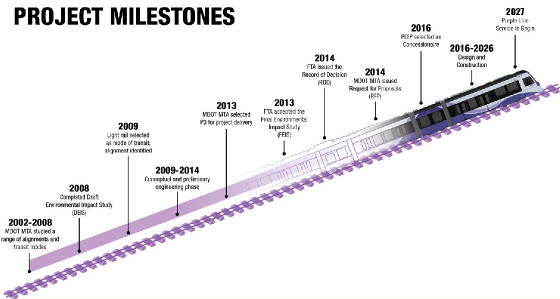
|
| MTA PURPLE LINE PROJECT COST IS APPROXIMATELY 10 BILLION DOLLARS - OVER 25 YEARS TO BUiLD |
"Four Factors Driving the Bus Operator Shortage (And What to Do About Them)" - Streetsblog USA (2022)
"Nearly a dozen children have been hurt in the recent string of shootings. Mayor Parker vowed to 'use every legal tool
in the toolbox' to address the violence."
"Farming Prioritizes Cows and Cars - Not People: Farmers and Scientists Are Getting Better at Growing More Crops on Less Land,
but They're Not Focusing on Plants that People Eat." - Wired (2024)
Now Costs 10 Billion and opening delay to December 2027.
Car-Free
"King of Sprawl" ~ "Monument of Man's Arrogance" "What's Going To Happen To Phoenix By 2050?" - Thomas Y (2023)
Tempe, Arizona: "A Look at America's First Car-Free City" - CNBC Television (2024)
"Living Car-Free in the Arizona Desert: Inside Culdesac Tempe [Walking tour] - Kirsten Dirksen (2024)
Financially poor live where they pretty much always lived, unless forced to leave. With streetcars stolen, strategic bus
service for decades is all that continues to be offered.
"The mode of transit service matters though. While poor families tend to live closer to bus service, the effects are
reversed with flashier and more expensive services like urban light rail, Tyndall says. Higher-educated and higher-paid workers
tend to congregate around light rail-accessible neighborhoods, which raises employment rates — and rents — in
those areas, while lowering poverty. But the displacement impacts of light rail amenities can actually reduce overall employment
across a wider area, by pushing lower-income people to neighborhoods with worse transit access."
Search, "Bus for poor" and "Maryland Transportation Administration" (MTA), or "Maryland Department of Human Resources' "Transportation
Assistance Program" (TAP) may and does show up at top of search list. TAP, a state funded car-centric program, addresses
need MTA creates because of MTA's disgraceful lack of providing proper public transportation. "It isn’t unusual
for low-income families to spend four to five hours a day commuting to and from work, sometimes taking multiple modes of transportation."
"It isn't unusual for low-income families to spend four to five hours a day commuting to and from work, sometimes taking multiple
modes of transportation. .... When parents have shorter commutes, children are much more likely to play on sports teams and
participate in special after-school activities. Without the restrictions of public transit, families can take advantage
opportunities for enrichment that weren’t previously possible."
Riding the Bus: "18 Habits that Society Considers Lower-Class" - MSN (February 20th, 2024)
"The Middle Class Go by Train, While Poor Wait for the Bus" - The Guardian (2002)
"Today, race, socioeconomics and transportation remain intimately linked. Bus riders across the nation are poorer and more
likely to be minorities than those traveling by car. Since the recession, more than 70 percent of the nation's transit agencies
have cut service or raised fares, according to the American Public Transportation Association, having a disproportionate impact
on the poor. .... Nowhere can the ties between transportation and racial and economic inequality be seen more clearly than
in Baltimore. ....
This summer’s $135 million overhaul of Baltimore’s bus system {Baltimore Link} aimed to improve its reliability
and connectivity. But it immediately drew angry cries of frustration, as some riders complained of delays and new bus routes
that meant having to wait on some of the city’s most dangerous streets. ....
‘Waiting for equity’ ....
Everywhere she looks, she sees the open wounds of trauma. 'It’s a sad city. There’s a lot of sadness here,' she
said. But, 'Within trauma, too, is community. Tragedy is community.'
For now, Wallace’s project of documenting Baltimore’s buses and bus stops continues. She continues to wait, and
she continues to learn. And it’s not just the bus that she is waiting for.
'A lot of us are just waiting for equity,' she said, as the bus rumbled down the avenue. 'We've got to get ours.
When are we going to do that? When are our schools going to get better? When are our neighborhoods?'"
"A Free Bus May Offer Wes Moore the Fastest Route to a More Prosperous, More Equitable Baltimore" - The Baltimore Sun (2022)
"BALTIMORE, With a Population of About 580,000, has uniquely bad transit for a city of its size. Its system,
run by the Maryland Transit Administration, a state agency, is a model of inconvenience. Riders endure one or
more long bus commutes (with traffic, 90 minutes or more each way is not unusual), often enough in slow-moving traffic,
to get across town. Jason Haeseler, a math teacher at Patterson High School in East Baltimore, has a shorter, one-seat bus
ride from his home in the same neighborhood, but he gets an earful from his students, who commute from all over Baltimore
to attend one of the most diverse schools in the city—some of them need three bus transfers to get there."
State of Maryland Ranks #43 of 50 States in Transportation - U.S. News and World Report (2023)
"Public transportation in the US just isn’t keeping up with that in other countries or with the needs of average Americans.
Between solo drivers and carpools, three-quarters (75%) of US commutes by car. As rents rise and urban areas continue to sprawl,
Americans, especially the working poor, spend more time commuting and more money on cars and insurance.
In a 2021 study, Texas A&M found that congestion in our 15 biggest cities costs close to $7 billion. Meanwhile,
over the past 65 years, the United States has spent nearly $10 trillion of taxpayer dollars on highways and roads.
Just a quarter of that was spent on public transportation."
"The Real Reason American Public Transportation is Such a Disaster" - Vox (2015) [Still the Same]
Moss in the Landscape
Maryland Crash Data - Zero Deaths Maryland
| NEW INFORMATION ~ BEING REWRITTEN & REORGANIZED |

|
| PLEASE VIEW WHAT IS AVAILABLE |
PLEASE START BELOW WITH THE GREEN QUOTE & "TRANSPORTATION DIRECTORY" BELOW.
UNDER CONSTRUCTION.....
"Travel is fatal to prejudice, bigotry, and narrow-mindedness, and many of our people need it sorely on these accounts. Broad,
wholesome, charitable views of men and things cannot be acquired by vegetating in one little corner of the earth all one's
lifetime." ― Mark Twain, The Innocents Abroad
Often misquoted as, "Travel is the death of ignorance."
"Traveling by public transportation is 10 times safer per mile than traveling by automobile.
A person can reduce his or her chance of being in an accident by more than 90% simply by taking public transit as opposed
to commuting by car."
"The poor are often stuck in urban neighborhoods with the fewest transportation options for getting to jobs, childcare,
healthcare, {shopping}, and … that makes it harder for them to climb out of poverty and exacerbates inequality.
Without adequate transit for the less-advantaged, opportunity will tend to pass them by, like overcrowded
buses on a cold winter day."
- Harvard business professor Rosabeth Moss Kanter, Move: Putting America’s Infrastructure Back in the Lead
Kansas City Streetcar Authority executive director Tom Gerend shares how Streetcars earn their keep by being revenue streams
generated by tax districts:
"We have a taxing jurisdiction where we collect a fare indirectly off the economic activity. People ride our system: they
shop at businesses, they go to restaurants, they stay in hotels. The more people we move, the greater the economic
impact. And we get to capture some of that through an indirect fare on those economic transactions in a way that creates
this sort of symbiotic relationship."
"Focused thought and all funding resources must be completely on public 'Rail-only' transportation being a weapon against
Climate Crisis, Poverty, Racism, Segregation, Classism, Noise Pollution, and usher Quiet and Speed of people, goods, and services.
This is nothing new. It is merely about a Rail Renaissance - what Baltimore started in the first place - Transport Freedom."
- Shaiyel Seltzer, October 21st. 2023 1:11 PM
Rails are - and will always be faster than roads.
TRANSPORTATION PAGE DIRECTORY

Let me know
Do I still got time to grow?
Things ain't always set in stone
That be known, let me know ....
See, I know my destination, I'm just not there
In these streets
In these streets
I'm just not there in these streets
I'm just not there
Life just ain't fair
| LET THEM BE!!!! LET THEM TRAVEL!!!! |
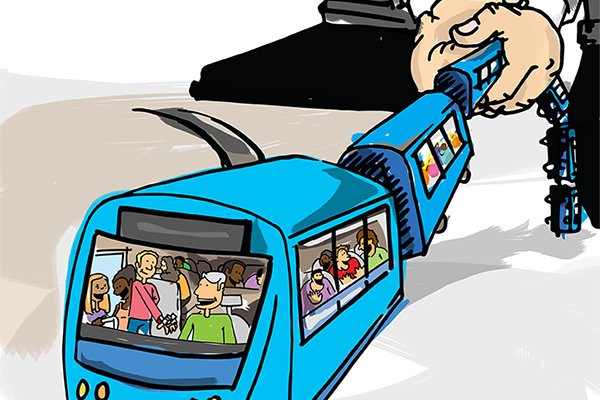
|
| TRAIN & STREETCAR STRUGGLEHOLD |
Streetcars = Trams, have and always will be the superior transport. Sense of inevitability and the desire to reinvent
the world. A lot of profit in eyeballs on who are along the streets - small businesses. Want them? They left along time
ago. Light Rail is a type of streetcar, concepted for short car life (30 years at best), little travel on actual streets
with deforested areas for people who already have tired-vehicle transportation.
Streetcar lifespans? We may not ever know.... because many are still currently running full routes 125+ later....
"Our struggle is not over.
The physical signs are gone, but the legacy of 'Jim Crow' transportation is still with us."
- U.S. House Representative John Lewis, Highway Robbery: Transportation Racism and New Routes to Equity
"I bought the Red Car - so I could dismantle it."
- Judge Doom, "Who Framed Roger Rabbit"
Film based on L.A. Red Car Streetcars. Judge Doom mission: In order to convert Los Angeles into a nirvana of freeways and
gas stations and drive-in restaurants....
"Explicit subsidies, which cut the price of fuels for consumers, doubled in 2022 as countries responded to the higher energy
prices resulting from Russia's war in Ukraine. Rich households benefited far more from these than poor ones."
~
TRAINS GAVE BALTIMOREANS & MARYLANDERS PROSPERITY & EQUAL FOOTING, WHICH IS NEARLY DESTROYED BY PRIVATE TRANSPORTATION
Writer unaware that Kansas City has already extended mentioned line, built, and opened other streetcar routes.
| NEW INFORMATION ~ BEING REWRITTEN & REORGANIZED |

|
| PLEASE VIEW WHAT IS AVAILABLE |
☸
UNDER CONSTRUCTION - THIS SECTION IN WHITE TEXT IS BEING REWRITTEN:
Public transportation, and its infrastructure's main goal is to move large numbers of people quickly, reliably. and efficiently.
So why does the United States not only resist, but hates to offer its citizens this type of transport that most everywhere
else n the world gives? Is it as simple as love and hatred of its citizens?
The 1800's technological developments and success of implementation of the Baltimore & Ohio Railroad route, integrated with
the Telegraph, captured the concept that intertwining is the best way, which resonated with the rest of the United States
and Territories, and demanded them too. Today, it is the integration of computing and telecommunication technology, but it
is urgent to include previous technologies that have been severely neglected, or even disappeared.
The reason for rail having such a roaring comeback is because of advancements of Europe, Asia, South America, and Australia,
for their priorities are of their citizens welfare, for they listen. Listen and build. Listen and build. Their Generation
"Y" (millennial) and "Z", just like in the United States, do not want to purchase automobiles, evidenced by a drastic
drop of even obtaining driver's licenses. Yet these generations want total freedom of movement. The rest of the world
never have their government dictate as to where they can and cannot go, and when, to be able to go anywhere they want by multi-modal
means: trams/tramvays/tramways/streetcars, hi-speed trains, subways/metros and aerial cablecars, and they want to go fast
- with shorter routes and timed transferring stops for every single line so little to no wait through circle loop-oriented
systems. They are able to afford to purchase homes.
Meanwhile, the United States continues to embrace domination of tire, car, and oil/petroleum manufacturers and producers;
especially when continuing to spend millions dismantling train tracks for concrete/asphalt bicycle paths, oblivious that we
desperately need the trains to once again all run to best combat climate change. High-speed trains offer quicker than travel
to airport and flight trips. Political interests drive American Exceptionalism, with even the highest elected officials picking
winners and losers; promoting endlessly through speeches electric charged batteried tire-vehicles with not a word about hydrogen-fueled
vehicles.
Concrete/Asphalt/Cement/Tar/Coal Tar and a host of other products come into play, and businesses fight to be rich in contracts,
no matter the breathing cost especially of Baltimore City children who are given the gift - of asthma.
Child and slave-waged workers are used in mining toxic chemicals for electric batteries, and will not ruin roads, tunnels,
and bridges... with that will never be built for . when hydrogen- fuel needs
It is clear; having foundation of integrating only true zero carbon emission local transit - Streetcars, with "smart"
is win-win scenario to combat air, water, soil, and noise pollutions and embracing changing climate solutions to provide all;
kindred living.
Of all city and state departments, Transportation is most contentious, as no one thinks they get enough of what they want.
Though government is supposed to serve the public good, meaning serving all, public transportation mostly
fighting for money. In terms of a state, it is then, in State of Maryland case, Baltimore City and 23 Counties all fighting
for dollars. But, State of Maryland is at same time different, for it interjected itself in 1970 to make a Baltimore Region
plan, taking over Baltimore City's Transportation System, whose system consisted of streetcars only 7 years before. Just
one change would of brought the streetcars come ringing back, "Dedicated Lanes," meaning Streetcars only, with little lane
borders to keep out cars.
No segment or group of State of Maryland has any iota any slightest idea that climate crisis - "global boiling" is afoot directly
regarding public transportation. No longer can people in Baltimore City and Region be waiting for hours in plastic boxes
sitting on metal benches (few are offered in first place). Wet bulb and heatstroke in summer, and more frigid temperatures
in the winter will bring more deadly numbers - specifically due to the State of Maryland Government: Governor Moore, Senators,
Delegates.... - Maryland Department of Transportation, Maryland Transportation Administration, Baltimore City Government:
Mayor Scott, Council President Mosby, City Council, Baltimore City Department of Transportation, Baltimore Metropolitan Council....
"Share Your Transportation Story: Wynton Marsalis" - U.S Department of Transportation (2016)
Twas the famous Supreme Court case that all started with a train ride. The train owners did not want to segregate. Florida
& Louisiana governments did. Restoring equitable transit - Streetcars, are - the heart of
Reparations.
"Anthem - Grow Grow Grow" - Little Anthony & The Imperials
Communing with nature should always be a trip one can take, not a "special trip" that only an automobile can reach; especially
due to being able to take public transit long ago via streetcar - trolleycar. Forced that buses were better, it immediately
created segregated transportation: easy to cut due to no fixed rails. Automobile-purchase means became the new way, for instance,
to go to nature state parks.
An Awakening is occurring all across the United States. Upon reflection of the all-electric no battery, no motor original
and only true zero carbon emission public transit, the Streetcar is an upscale desire. Real estate developers
only demand one form of transportation: streetcars. Yes streetcars, not limited stop light rails. Streetcars on dedicated
lanes. Baltimore originated the electric streetcar in 1885. Now Baltimore must not just catch-up, but surpass in manifesting
a public transit system becoming completely streetcar-served. Fumes from exhaust, batteried cars cam help. but tires cannot
due to 6PPD Quinone (6PPD combined with Ground Ozone is toxic).
The cost of installing rails that were taken out, now needed again, is nominal compared to the damage done to the psyche of
transit segregation. And yet, it is VASTLY cheaper to build and run streetcars. The rails we know last hundreds of years.
The streetcars themselves (seats and all), evidenced by restorations, we know now last well over 100 years. There
is only one continuous operating line in the United States since its inception: 1835, the "Saint Charles" in New Orleans,
Louisiana (trolley pole electrified in 1893). They are using electric streetcars for over a hundred years.
Segregation and isolation, especially to African/Afro-Americans and Blacks who were racially discriminated against, and all
who, whether choice or not, do not own an automobile. It is clear, with the Noise and Noise Control Act of 1972 and later
bills, that streetcars were quiet, about 50-50 decibels, while gasoline buses are 80-95 decibels, well above the human ear
tolerance, thereby major hearing loss contributer. For too long bus transit has segregated some neighborhoods from others,
as well as cities and towns one used to be able to between. Example Baltimore -- Ellicott City. It is clear that Subway and
light-rail was built for commuters, those who mostly own cars and choose to take location-segregated destinations. Streetcars
connect what we call, "Americana": FARMS ~ RIVERS ~ STATE PARKS & TRAILS ~ SHOPPING ~ LIBRARIES ~ SCHOOLS ~ JOBS GALORE ~
AND MANY MANY PEOPLE WITH HOUSES WALKING AND ROLLING STRAIGHT ONTO ~ STREETCARS are the least costly, who demand for their
businesses which is way less costly though rails are needed, is the wave of the future - again.
STRUCTURAL RACISM IN TRANSIT AGENCIES:
"Why do suburban areas often have separate agencies from their big cities? There are legitimate reasons for this, but it seems
to happen a lot in areas where cities have largely Black populations and suburbs are predominantly white. In Detroit, not
only do the suburbs have their own agency that excludes the city, but by policy, those buses will not pick up Detroit residents
as they pass through the city."
Every transit line, every bit of infrastructure, every bus that runs down a street and every train
that runs down a track does so in pursuit of a motive. We cannot be neutral experts; we have to ask, what
those motives are. There are many — what I’ve talked about here is only one aspect of how transit represents
larger political goals, and only one dimension of how race and transit intersect. For example, the elevation of the idea
of transit as a development tool has put some transit agencies into the role of gentrifiers.
Paying for Shelter and Automobile = Neither "Poverty, Politics, and Profit" - "Frontline" & NPR - PBS (2020)
"Racism Has Shaped Public Transit, and It's Riddled With Inequities" - Rice University Series (2020)
"I just think it's crazy because you don't know if that person was going to work or going to see family. You don't know
what they were going to do. So, it's like, 'What was your reason?,' you know?"
"Climate trends affect the design of transport infrastructure, which is expensive and designed for long life (typically
50 to 100 years). The estimated value of U.S. transportation facilities in 2010 was $4.1 trillion. As climatic conditions
shift, portions of this infrastructure will increasingly be subject to climatic stresses that will reduce the reliability
and capacity of transportation systems. Transportation systems are also vulnerable to interruptions in fuel and electricity
supply, as well as communications disruptions – which are also subject to climatic stresses."
"Transit-Oriented Development (TOD), that is, efforts to create compact, pedestrian-oriented, mixed-use communities
centered around train systems), one of the older innovative transportation solutions, is very likely to reduce emissions
and help build resilience."
STREETCARS & TRAINS:
Overhead AC powered catenaries with trolley poles or pantographs are superior to third rail and safe. AC is superior
to DC, and uses less electricity. Hybrids are used - third rail for tunnels, thereby condensing the size (and saving money),
and rest are catenaries. All trains can benefit with catenaries. Catenaries make them be able to go faster.
TRANSPORTATION FOR ALL
"Transportation is always about the future. If we're just fixing today's problems, we'll fall further and further behind.
We already know that a growing population and increasing freight traffic will require our system to do more." - U.S. Secretary
Department of Transportation, Anthony Foxx [Obama Administration]
{Click Above}
"This chart shows average per-passenger fuel economy of various modes of travel. All forms of rail achieve relatively
high values because of high ridership, proportionally low drag, and high electrification rates (electricity
is inherently more efficient than combustion-engine propulsion). .... Transit buses are not very efficient at
their current ridership rates, where, on average, a given bus is less than 25% full. Demand response vehicles
are the least efficient because they need to use fuel just to get to the passenger."
Oak Ridge National Laboratory - Utah Battelle for the US Department of Energy
"Prepare for 3 Million to live in each city."
"The Surprising Way Small Towns Are Disappearing" - City Beautiful
Streetcar City & Suburbs - Canada - Not Just Bikes
EUCLIDIAN ZONING: "The Lively & Livable Neighbourhoods that are Illegal in Most of North America" - Not Just Bikes
Guess what? Baltimore, where Mayor Thomas Swann started horse-driven streetcars, led the invention of another, "Streetcar,"
a public transit system that ran exclusively on electricity - Electric Streetcars with Trolley Poles. The only problem:
no gasoline, tire, or automobile makers could make money. So they forced the streetcars to STOP. Forced. But they were
never outdated. Salespeople through out the ages, but particularly since the industrial revolution have destroyed
superior technology and scientific inventions, products, and services. And we are payin dearly for their monetary wealth.
Trolleys, Streetcars, and Cablecars, as well as Light Rails run on live connective electricity. In 1920, 1 in 10 Americans
owned an automobile. 1947 vision of auto manufacturers, tire companies, and oil barons forced streetcars to become eliminated,
thereby forcing buses onto the public. They even burned the trolleys, cablecars, and streetcars to insure they
would never return to the streets. Europe and the rest of the world went the other way after WWII: rebuilt their streetcars
and new trains. Year after year, Europeans that have such amenities, even free transit countrywide, are ranked, "HAPPY."
"EQUITY" - United States Department of Transportation

WALK N' ROLL
In 2020, 130 Pedestrians were killed in Maryland by motor vehicles.
This makes Maryland the 15th most dangerous place in the entire United States to walk.
2020 Pedestrian Killings by State - U.S. Department of Transportation
This page explores just what it takes to make a pleasurable walk, and how you can advocate for your walk to be - to getting
everything you want in life.

DONKEYS, HORSES, & MULES
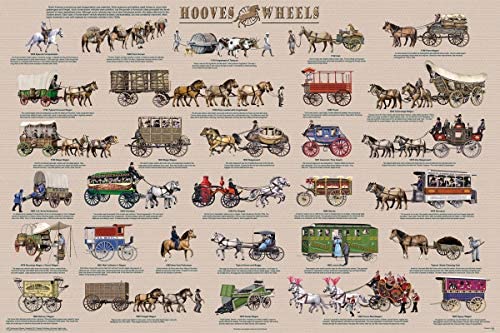
Prior to the internal combustion engine (trains), horses were the primary means of moving people and goods. In the United
States, cities and towns, horses and horse drawn vehicles remained the main transportation until the 1930s. The horse is not
native to North America. Spaniards brought horses to the "New World", sparking massive trade and purchase of their
horses, especially during the Louisiana Purchase. This picture is devoted to the most popular and famous horse-drawn vehicles
since the 1600's: Covered wagons, Conestoga wagons, various aged Coaches, freight-oriented horse vehicles, fire engines, Civil
War ambulances, circus band wagons, gypsy wagons, and funeral wagons.
"She was a wild young mustang, no bridle, no reigns,
Full of fire and spirit inside.
The last of a rare breed, born to run free,
The horse nobody could ride"
"Horsecars: City Transit Before the Age of Electricity" by John H. White, Junior - Miami University

Bicycles
This page asks for bicycle enthusiasts to take a step back and reflect whether the current city bicycle paths are truly
safe - especially for children, and whether hot sun beating on riders and pavement is truly the way. Let's explore Baltimore's
alleys, and let's turn them into Allées!

WHAT ABOUT TRAINS? "THE IRON HORSE"
EXCITING NEWS FOR THE TRAIN INDUSTRY! Ready? HYDROGEN RUN TRAINS!!!!
Who doesn't like a train ride? Without the train, there may of not been an industrial revolution. The train is the
invention of the 19th century. We use trains more than ever - for freight, and we need to use them even more. According
to physics: Train and streetcar transit are the most efficient ways to move people. Trains and streetcars are also safest
- as they do not have roll-resistance (no tires) and do not hydroplane. Trains have never been out of style. It is tired
vehicles that actually can be considered archaic.
"Look a-yonder comin'
Comin' down that railroad track
Hey, look a-yonder comin'
Comin' down that railroad track
It's the Orange Blossom Special
Bringin' my baby back....
Hey talk about a-ramblin'
She's the fastest train on the line
Talk about a-travellin'
She's the fastest train on the line
It's that Orange Blossom Special
Rollin' down the seaboard line"
"Orange Blossom Special" - "Heehaw" - Roy Clark & Jimmy Henley [Instrumental]
"Orange Blossom Special" - Roy Clark And Johnny Cash (1978)
LONG LIVE THE RAILS FOR THE TRAINS!!!!

WORLD CIRCLE LOOP LINES & BALTIMORE LEGEND
"And if I were king of the world
Tell you what I'd do
I'd throw away the cars and the bars and the war
And Make sweet love to you"
BUS & AUTO
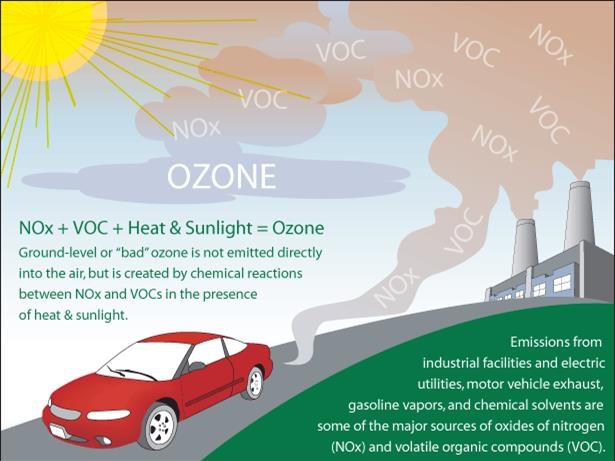
|
| United States of America Environmental Protection Agency (EPA) |

The United States Department of Energy states that hydrogen can be made without any production emissions - in process of making/separating
hydrogen, as well as what is left - just H2O - water: steam. Nothing to mine or recycle. The United States Department of
Energy states that zero emission energies, "Renewable energy, such as wind and solar" can well be used instead of biofuel
and gas. Hydrogen - "Fueled Cell" FAR supersede the batteried electric vehicle (BEV/EV). Electric-charged batteries
are made with toxic materials, primarily mined cobalt and lithium, child and adult slave wages, over lifetime will need at
least 1 new battery, and because needs large water cooling system, quite heavy, putting more pressure on tires - creating
tire erosion dispelling PPDs and PAHS strewn into air (we all breathe) - air pollution carcinogens that then become water
and soil pollution.
"Hydrogen can also be produced from water through electrolysis. This is more energy intensive but can be done using renewable
energy, such as wind or solar, and avoiding the harmful emissions associated with other kinds of energy production.
Almost all the hydrogen produced in the United States each year is used for refining petroleum, treating metals, producing
fertilizer, and processing foods. ....
Fuel Cell Electric Vehicle (FCEV) running on hydrogen emits only water vapor and warm air as exhaust and is considered
a zero-emission vehicle."
It is important that the current uses of hydrogen be freed through innovative means (reduction in petroleum mining will help
greatly). Gasification does and expanding, will be able to create hydrogen from trash, landfills, and used materials.
Reduction in use of petroleum will lower need for refining petroleum. Perhaps another treatment for metals can be found.
Perhaps there are other means of producing fertilizer (perhaps if not enough, all animals (including human solid waste).
Reduction of processing foods, such as using preservatives and other production means will also free up hydrogen to use for
fuel.
HYDROGEN POWERED VEHICLE PURCHASE INCENTIVES [Single and Fleet] - Hydrogen Laws and Incentives in Maryland - U.S. Department
of Energy
DEMAND FROM YOUR LOCAL & STATE OF MARYLAND YOU WANT TO PURCHASE FUEL CELLED HYDROGEN FUELED AUTOMOBILES. BUSSES, TRUCKS, TRACTORS....
AND HAVE HYDROGEN FUEL STATIONS
DEMAND, DEMAND, DEMAND HYDROGEN
" Efforts are also underway to expand hydrogen fueling locations in Hawaii and across the East Coast, with other markets
expected to develop as consumer demand increases."
Early Twentieth Century We Had Electric Automobiles: "Choosing Electric, Steam, or Gasoline Cars" - The National Museum of
American History
"Icy Temperatures Cut Electric Vehicle Range Nearly in Half: AAA Research Finds HVAC Use in Frigid Temperatures Causes Substantial
Drop in Electric vehicle range" - AAA (2019)
This page educates as to why we need to reduce the amount of tire-based vehicles we use - altogether.
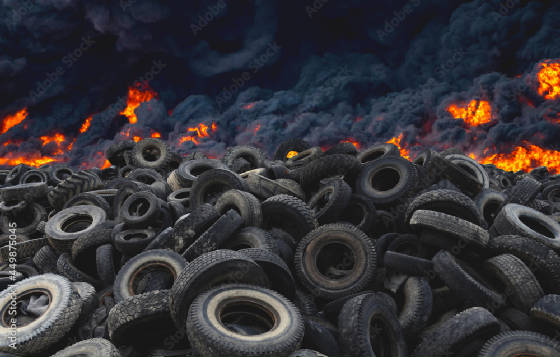
|
| BURNING TYRES |
| TIRE DUMPING ALL OVER MARYLAND |
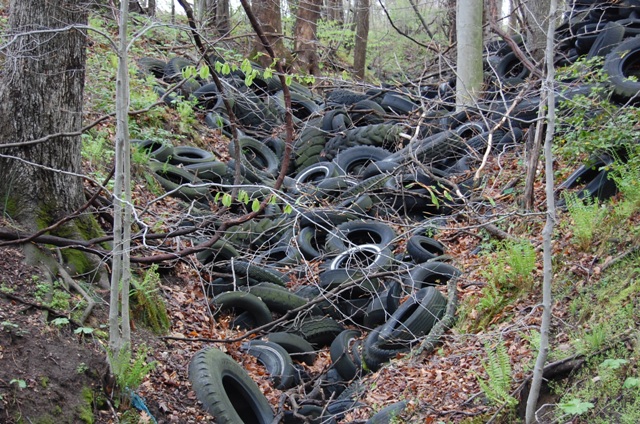
|
| TIRE DUMPING ALL OVER MARYLAND |
| COLORADO: TIRES TYRES EVERYWNERE - FROM EVERYWHERE |
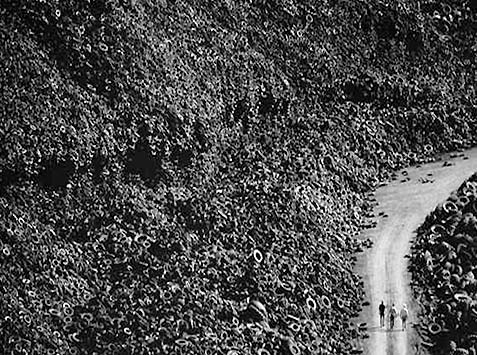
|
| COLORADO: TIRES TYRES EVERYWNERE - FROM EVERYWHERE |
| HUDSON, COLORADO: USED TIRE DUMP CAPITOL of USA |
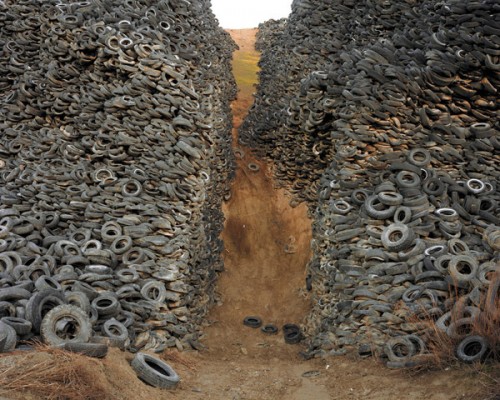
|
| HUDSON, COLORADO: USED TIRE DUMP CAPITOL of USA |
........................................................................................................................................................................................................................................................................................................................................................................................................................................................................................................
TIRES TYRES EVERYWHERE
DOUBLE AIR POLLUTION: EXAUST AND TIRE WEAR
"It's like a preservative for tires, similar to how food preservatives keep food from spoiling too quickly, 6PPD
helps tires last by protecting them from ground-level ozone.
Ozone, a gas created when pollutants emitted by cars and other chemical sources react in the sunlight, breaks the bonds
holding the tire together. 6PPD helps by reacting with ozone before it can react with the tire rubber, sparing the tires.
But when 6PPD reacts with ozone, the researchers found that it was transformed into multiple chemicals ,
including 6PPD-quinone (pronounced "kwih-known"), the toxic chemical that is responsible for killing the salmon ."
"Discovery of Tire-Related Chemical That Kills Coho Salmon Sparks Widespread Response" - Puget Sound Institute
The Scrap Tire Recycling Act Fund: February 1, 1992 for $1.00 per tire.
April 1st, 2005 - Massively changed. Charges only 80¢ for ONE tire. "To collection of only 80¢ fee per tire only
on first sale of each new tire."

HIGHWAY TO KNOW-WHERE
"And out from the echoes of the night
Concrete caverns catch the sky and hold the stars to ransom
A thousand dreams it's getting late....
Well there's a new world bricking in the Old World charm
Suburbs' highway pass cicada-coloured farms
Buy a car, sell a car, lead a car away"
"Koala Sprint" - Midnight Oil
"I see buildings, clothing the sky, in paradise"
"The Power and the Passion" - Midnight Oil
"Carefree highway
Let me slip away on you
Carefree highway
You've seen better days"
"Carefree Highway" - Gordon Lightfoot
On This Page: Historic comprehension of Baltimore highways: especially Interstate 70 (changed to "Route 40" when
not fully "built"), destroyed homes, disengaged neighborhoods, destroyed our electric travel system - the streetcar,
and further segregated people by not only race, but class due to automobile. This page also explores creative wind and solar
art that is not only beautiful, but are powerful energy conductors, helping those highways and other roadways that stay.


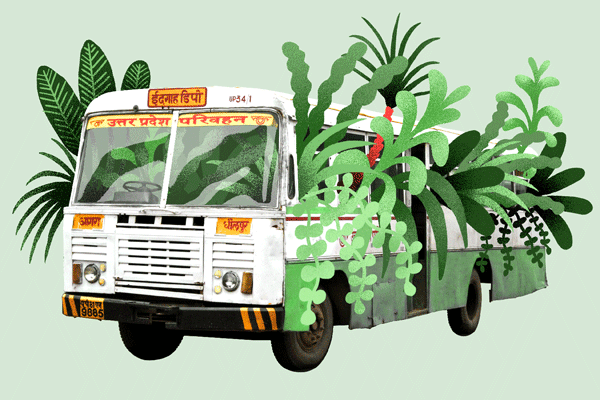
|
| The New York Times (2017) Illustration by Cari Vander Yacht |
THE COUNTRY OF INDIA HAS SPOKEN:
BUSSES ARE - OF THE PAST.
Now - What do we do with them? Continue to invest in more expensive over time tired-vehicles that hurt us immediately?
"The Streetcar Renaissance Trundles Into Calcutta: Cheap, Eco-Friendly Tramcars that Once Provided Transit for the Masses
Appear to be Staging a Comeback. - Next City (2013)
MARYLAND VERSUS THE NETHERLANDS
HISTORY OF TRANSIT
126 West 25th Street
Baltimore, Maryland 21218
Tel: 410-889-3566
MARYLAND DEPARTMENT OF TRANSPORTATION: MDTA & MTA
NOISE POLLUTION

TRANSIT COMPARISON
This page we compare and contrast two transit systems: Baltimore, Maryland and Portland, Oregon.

WE WANT STREETCAR ROUTES NOW
This page lists proposed routes, starting with routes where the tracks are currently still intact. For Example: Baltimoreans
and Elliott Cityians have not been able to travel daily (non-commuter) to each other in multiple decades. Last streetcar
run between was 1955.
| ALWAYS ADDING NEW INFORMATION & LINKS |
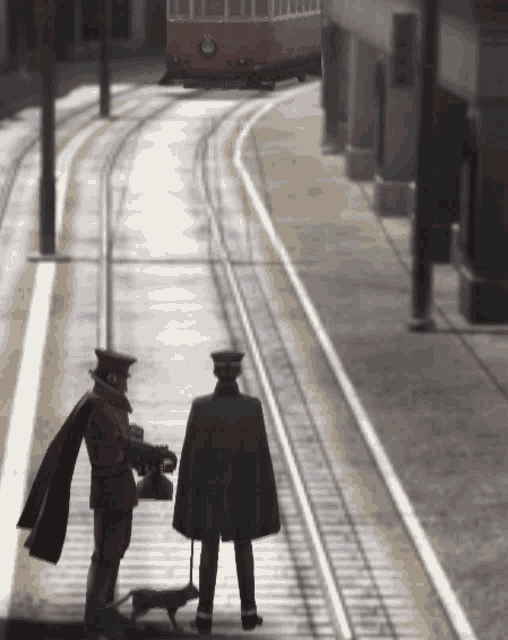
|
| COMING SOON |

STREETCAR TROLLEY FILMS, MUSIC, & FOLKLORE

TRAIN AND STREETCAR CAREERS

Baltimore Transportation Pictures
| ALWAYS ADDING NEW INFORMATION & LINKS |

|
| COMING SOON |
BALTIMORE LEGEND

TRANSPORTATION REPARATIONS
The streetcars worked fine. With the invention of the automobile, over years more and more people purchased them but kept
their same habits - they all wanted to and went downtown. Congestion on streets not made for automobiles or trucks, nor for
their parking occurred none the less. Baltimore City Government paid for studies from various other citied firms. only to
do nothing. Automobile drivers continued to demand their passage, and the once dedicated laned streetcars had not only competition
for traveling on their own lanes, but made them slow and no longer "on time." All the streetcar companies, all privately
owned, became Baltimore Transit Company (BTC). Not in secret, but not out in the open either, some members went ahead and
agreed to sell to National City Lines. Baltimore Transit Company was already investing in Baltimore Coaches - busses, but
was not intending to end streetcar service. Two stockholders of Baltimore Transit Company sued.

MARYLAND VERSUS THE NETHERLANDS

FERRIES ~ COMEBACK AGAIN
Vehicle drivers in 1952 started to decide, that though farther, they would take the Chesapeake Bay crossing in the air - the
William Memorial Bridge. Less and less vehicle drivers took their vehicles via ferries, and many stopped service.
The issue is that ferries also took people across without a vehicle. Bicycles too. The bridge builders did not choose
to place a lane for walking, rolling (wheelchairs, baby carriages...) and bicycles. Since there will not be a new bridge
for at least 11-14 years, if at all, it is time to redo the use of the current bridge. Why tease people by one day a year
that one can walk on the bridge? Everyday use allows people to get to where they want and - not take up space with an automobile
or pollute (exhaust and from their tires).

AIRPLANES, BALLOONS, BLIMPS, & JETS

WORLD TRANSIT
| ALWAYS ADDING NEW INFORMATION & LINKS |

|
| COMING SOON |

DIRT BIKES, MOPEDS, MOTORCYCLES, and SUBWAYS
| ALWAYS ADDING NEW INFORMATION & LINKS |

|
| COMING SOON |

TRAINS VERSUS TRUCKS AND VANS
"Why The Trucking Industry Is So Fragmented And Chaotic" - CNBC (2021)

FREIGHT: TRAINS & TRUCKS
DRIVERS IN VEHICLES KILL HUMAN BEINGS
"Long-Range Plan Contemplates Nearly $4 Billion for Baltimore Region Transit Corridors" - Maryland Matters (May 2023)
"How to Get People on Transit" - RM Transit (2023)
In Baltimore, streetcars can succeed where buses have failed | READER COMMENTARY
For The Baltimore Sun
•
Published: Jan 20, 2023 at 7:29 am
The Kansas City Streetcar, launched in 2017, runs along Main Street in Kansas City, Missouri. (Orlin Wagner/Associated Press).
(Orlin Wagner / AP)
I love it when people from Fallston purport to care or know anything about Baltimore’s underachieving public transit.
But what is startling about a recent missive from that transit desert is the recommendation that The Baltimore Sun Editorial
Board “get past” the Red Line and print an article by Warren Buffett urging a “more flexible” bus
system in lieu of streetcars or light rail for Omaha, Nebraska (”Will The Sun’s editorial board ever get past
the Red Line cancellation?” Jan. 13).
Leaving aside the oblique insult that Baltimore can’t do any better than Omaha, it appears that the correspondent has
been asleep for the last five years. Baltimore did get a new and highly-touted bus system beginning in June 2017 called BaltimoreLink.
It was a failure. It lost one-third of its ridership in the first several weeks when fares were waived and rides
were for free. It was so bad that there were overflow meetings in the War Memorial Plaza during the summer of 2017
from enraged transit riders including myself. At that time, a one-way commute on transit averaged 90 minutes, and
the BaltimoreLink in its infancy was performing even worse.
Bloomberg Businessweek reported in 2019 that ridership was still flat and 66% of these BaltimoreLink buses would show
up late or not at all. During the first year of its operation, BaltimoreLink did not have a map of itself. It also became
clear in the post-BaltimoreLink era that children taking the Maryland Transit Administration buses from 8th to 12th grade
could not rely on the BaltimoreLink to get them to and from schools in a safe, timely and reliable manner.
It has also become apparent to me that the buses run for employees by University of Maryland and Johns Hopkins are much
more efficient, timely and reliable than the MTA. There have been times when I watched four or five Hopkins buses pick
up passengers while crowds gathered to stuff a single tardy MTA Brown Line bus like sardines. If the BaltimoreLink
were such a rousing success or at least a fraction of what it promised, newspapers, politicians, and activists like myself
would not be rethinking the concept of the Red Line.
Instead of the experience of Omaha, I would like The Sun and any powers-that-be to share the success story of the free
2-mile-long Kansas City streetcar, which bolstered downtown revenues and businesses to the extent that four more miles
of free streetcars are being considered.
— Paul R. Schlitz Jr., Baltimore
"Automobile dependency and sprawl create communities where it is easy to drive but difficult to get around by other modes.
This is unfair to non-drivers and increases many costs. This report investigates the roots of these problems:
planning distortions that favor driving over other modes and dispersion over compact development. To be fair and efficient,
planning must reflect certain principles including consumer sovereignty (it responds to consumer demands), fair
share investments (each group or individual receives comparable public resources), efficient pricing (travellers pay
for the infrastructure they use), comprehensive analysis (it considers all significant goals and impacts), and accessibility-based
analysis (it maximizes access not mobility). This report identifies common planning practices that violate these principles,
evaluates their impacts, and recommends reforms for efficiency and equity. This analysis indicates that given better options
and incentives, travellers would drive less, rely more on non-auto modes, save money, and be better off overall as a result."
"Why Philadelphia's Streets Are Better Than Other North American Cities" - Alan Fisher (2022)
Subway Secret - City Harvest (2010)
Click on arrow to view the testimony by Delegate Lewis. Sad that the co-sponsors did not testify, or even attend to support.
Bill, "died."
MD HB341: "EQUITY IMPACTS" Transportation - Statewide Transportation Improvement Programs - State of Maryland House of Delegates
CELEBRITY PUBLIC TRANSPORTATION ADVOCATES
........................................................................................................................................................................................................................................................................................................................................................................................................................................................................................................
|
